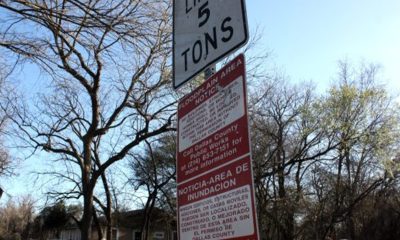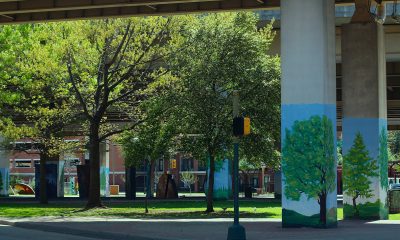City Government
Oakland ‘Dumps’ Waste Management
Waste Management (WM) lost out on a billon-dollar, 10-year contact to handle trash removal and recycling for Oakland when the City Council went for a more compelling proposal by a homegrown West Oakland Company that practices local hiring and is willing to offer the services that the council has asked for.
Though the vote went 8-0 for California Waste Solutions (CWS) and rejected Waste Management at the last City Council meeting, the nation’s largest trash hauler this week made a last ditch attempt to sway the council.
< p>CWS already handles recycling in half of the of the city and has a facility in West Oakland at and has promised the community it will move its operations to a new plant that it will build at the Army Base.
Councilmembers have reported that they have been under a lot pressure this week, but they stuck to their decision.
“We’ve been getting pressured, but what’s important to me is doing what is best for Oakland residents,” says Councilmember Rebecca Kaplan.
WM took its complaints to some of the local media, which seemed to be outraged on behalf of the company. The company has hired lobbyists, including former City Council President Ignacio de la Fuente, and has threatened to file a lawsuit.
Though negotiations are over and the votes were cast, the company this week came out with a new, sweeter offer. Waste Management was trying to influence the council ahead of its second vote Wednesday night whether to reaffirm the decision in favor of CWS at the July 30 council meeting.
Councilmember Lynette McElhaney led the opposition on the council to the Waste Management bid even though city staff had presented what she called highly biased and “slanted” staff reports in favor WM, which has picked up trash in Oakland as long as anyone can remember.
CWS offers a better deal for city resident starting with a considerable savings on rates, especially to commercial customers, according to McElhaney. CWS also has provisions for local hiring and plans to create a customer call-in center in Oakland, which WM closed down and moved out-of-state several years ago at the cost of local jobs.
In addition, CWS has listened to the council’s priorities, working with Civicorps, a nonprofit based in West Oakland, to create jobs for young people and is partnering with East Bay Municipal Utility District (EBMUD) to convert organic waste to energy to reduce electricity rates.
Like any newcomer that replaces an incumbent, CWS still has to overcome a lot of skepticism about its capacities. At this point, the company is set to purchase equipment, and expand operations, getting up to speed for a smooth transition when its trucks roll at the end of June 2015.
The company says it has backup provisions, plans A, B, C and D in place to ensure that all transitions will be seamless.
Ultimately, the council voted Wednesday night 7-1 for CWS, opposed only by Noel Gallo, who favored Waste Management. “I vote for the best rate and the best service for the long haul,” he said.
Praising the decision, Councilmember Rebecca Kaplan said the council had to stand fast when staff pushed for a Waste Management deal that would have meant trash pickup rate increases of
45 percent or more. Because the council pushed for a better deal, the rate increases will be less than half of that original amount, she said.
In addition, Kaplan said staff stacked the deck in favor of Waste Management by shaving six months off its contract. With six months less, a competitor like CWS would have under a year, rather than a year and half to prepare for taking over waste pickup in Oakland.
Councilmembers and people attending the council meeting applauded former Mayor Elihu Harris, who with his then aide Councilmember Larry Reid worked 22 years ago to help CWS get a start in West Oakland.
“I appreciate that you (the council) have faith in a local company,” said Harris, speaking at the end of meeting. “That is what Oakland is all about. (About) 70 percent of their employees are Oakland residents – that’s what Oakland is all about.”
Activism
Oakland Post: Week of April 17 – 23, 2024
The printed Weekly Edition of the Oakland Post: Week of April 17 – 23, 2024

To enlarge your view of this issue, use the slider, magnifying glass icon or full page icon in the lower right corner of the browser window. ![]()
Bay Area
Oakland Finishes Final Draft of Downtown Specific Plan for Potential City Improvements
In late March, Oakland’s city administration announced the final draft of their Downtown Specific Plan, a blueprint for city improvements and developments over the next 20 years. The comprehensive 474-page plan lays out policies for downtown developments that will increase economic, social and cultural, and communal opportunities for residents and workers who frequent this essential hub in Oakland.

By Magaly Muñoz
In late March, Oakland’s city administration announced the final draft of their Downtown Specific Plan, a blueprint for city improvements and developments over the next 20 years.
The comprehensive 474-page plan lays out policies for downtown developments that will increase economic, social and cultural, and communal opportunities for residents and workers who frequent this essential hub in Oakland.
Several departments over the course of eight years developed the plan, with two phases that emphasized a need for community input from local stakeholders, such as leaders and residents, and a focus on the role of social and racial equity in past and future developments.
Throughout the extensive plan, the concept of equity for marginalized communities is embedded with each goal and priority for the improvements to downtown. It acknowledges that social and racial barriers are preventing these communities from thriving on an equal playing field.
The authors identified six key disparities, or ‘equity indicators’, that set the baseline for how success will be measured for the improvements. These indicators include the burden of housing costs, homelessness, displacement, disconnected youth, unemployment rate and median income.
The plan is also broken up into chapters, each describing a major issue or topic that is plaguing downtown residents and workers, such as mobility, culture preservation, community health and sustainability, and land use and urban design.
Within each chapter, the authors dedicate a section to the impacts of the COVID-19 pandemic for the various areas of interest, illustrating how disparities and inequities increased before and after the disease’s peak.
Two major issues highlighted in the plan are economic opportunity and housing and homelessness. Both of these issues have been aggravated by the pandemic and require substantial support and resources to move forward.
Many reports coming out of the commercial and residential districts downtown have blamed the rise in crime and cost of living as reasons for leaving Oakland for other cities or closing down indefinitely.
The plan attributes rising rents of both residential and commercial properties to the displacement of local businesses and entrepreneurs. Downtown also has an imbalance in the jobs to housing ratio, which limits access to jobs as commuting distances increase.
Other concerns for the local economy are barriers to employment opportunities for workers of color, non-English speakers, and those with limited access to transportation. As stated in the plan, downtown also has a lack of vacancies near public transit hubs, such as BART, bus stops or ferry terminals, which could save workers money and time for their commutes into the city.
According to the downtown plan, the average unemployment rate for the white population was 5.9%, but the Asian population was at 6.7%, and for the Black population it was even higher at 10.4%.
The proposed solutions for the lack of economic prosperity include providing assistance to local businesses owned by people of color, reinforcing downtown as the ‘place to be’ for nightlife entertainment, and building businesses closer to public transit.
The addition of over 18.3 million (m) sq. ft. of new commercial space, 1.3m sq. ft. of new institutional space, and 500,000 sq. ft. of new industrial space, could potentially create almost 57,000 jobs downtown.
Housing and homelessness, issues closely tied to economic prosperity, are top concerns for Oakland residents. High rents have led to displacement and homelessness for those unable to keep up with the rising costs of the Bay Area.
Over 5,000 people are currently experiencing homelessness in Oakland, according to 2022 Point In Time data. 60% of this population is Black despite only making up nearly 20% of the total city population.
The plan explains that by adding nearly 29,000 new homes and expanding affordable housing units across the city by 2040, this would help alleviate the stress of obtaining and affording a home.
Strategies proposed to tackle the housing and homelessness crisis include increasing renter protections, providing additional shelters and services for homeless residents, and promoting homeownership in downtown with first-time buyer assistance and proactive assistance to vulnerable homeowners.
The plan acknowledges that the implementation of changes and developments amongst the several concerns outlined in the document will take time, both in short and long term periods.
To better explain how and when each project will be addressed over the course of the next two decades, a detailed 123-page graph shows which agencies, potential funding sources, and costs come with the goals.
The Oakland Planning Commission and Landmarks Preservation Advisory Board will each hold public hearings regarding the final draft of the Downtown Plan in May and June.
City Government
LAO Releases Report on Racial and Ethnic Disparities in California Child Welfare System
Racial inequalities in California’s child welfare system disproportionately impact poor Black and Native American children, according to a report released April 3 by the nonpartisan Legislative Analyst’s Office (LAO). The report, which was presented to the Assembly Subcommittee No. 2 on Human Services — chaired by Assemblymember Corey Jackson (D-Moreno Valley) — states that the proportion of low-income Black and Native American children in foster care is four times larger than other racial and ethnic groups in the state.

Racial inequalities in California’s child welfare system disproportionately impact poor Black and Native American children, according to a report released April 3 by the nonpartisan Legislative Analyst’s Office (LAO).
The report, which was presented to the Assembly Subcommittee No. 2 on Human Services — chaired by Assemblymember Corey Jackson (D-Moreno Valley) — states that the proportion of low-income Black and Native American children in foster care is four times larger than other racial and ethnic groups in the state. Half of the children from each racial group has experienced some level of child welfare involvement before reaching legal age.
Jackson is a member of the California Legislative Black Caucus.
“Racial and ethnic disproportionality and disparities are present within initial allegations and persist at all levels of the system — becoming the most pronounced for youth in care,” the report states.
The disparities have persisted over the last decade across the state, the LAO found, adding that Black children living in poverty are more likely to enter foster care. State data shows that there is a correlation between poverty and foster placement in each county.
“Throughout all levels of the child welfare system, families experiencing poverty are more likely to come to the attention of and be impacted by the child welfare system,” stated the report.
Overall, the report revealed that more than half of the families affected by the state child welfare system earn $1,000 per month, significantly less than the national average of $5,000 a month.
The financial disparities highlighted in the LAO report align with existing research indicating that poverty is among the main factors contributing to the likelihood of child maltreatment. State anti-poverty programs include cash aid, childcare subsidies, supportive housing, and nutrition assistance.
-

 Activism4 weeks ago
Activism4 weeks agoOakland Post: Week of March 20 – 26, 2024
-

 #NNPA BlackPress3 weeks ago
#NNPA BlackPress3 weeks agoCOMMENTARY: D.C. Crime Bill Fails to Address Root Causes of Violence and Incarceration
-

 #NNPA BlackPress4 weeks ago
#NNPA BlackPress4 weeks agoFrom Raids to Revelations: The Dark Turn in Sean ‘Diddy’ Combs’ Saga
-

 #NNPA BlackPress3 weeks ago
#NNPA BlackPress3 weeks agoMayor, City Council President React to May 31 Closing of Birmingham-Southern College
-

 #NNPA BlackPress4 weeks ago
#NNPA BlackPress4 weeks agoCOMMENTARY: Lady Day and The Lights!
-

 Activism3 weeks ago
Activism3 weeks agoOakland Post: Week of March 27 – April 2, 2024
-

 #NNPA BlackPress4 weeks ago
#NNPA BlackPress4 weeks agoBaltimore Key Bridge Catastrophe: A City’s Heartbreak and a Nation’s Alarm
-

 #NNPA BlackPress4 weeks ago
#NNPA BlackPress4 weeks agoBaltimore’s Key Bridge Struck by Ship, Collapses into Water



















































